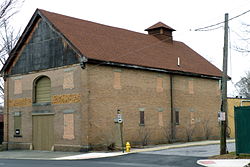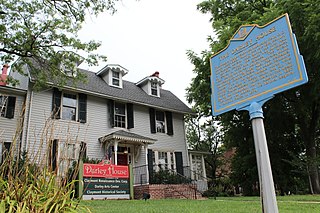
Claymont is a census-designated place (CDP) in New Castle County, Delaware, United States. The estimated 2017 population of the 19703 ZIP code, which Claymont encompasses, was 15,292.

New Castle is a city in New Castle County, Delaware, United States, six miles (10 km) south of Wilmington, and situated on the Delaware River. According to the 2010 Census, the population of the city is 5,285.
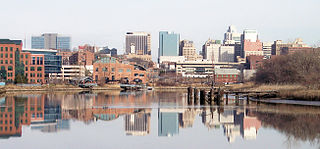
Wilmington is the largest and most populous city in the U.S. state of Delaware. The city was built on the site of Fort Christina, the first Swedish settlement in North America. It lies at the confluence of the Christina River and Brandywine River, near where the Christina flows into the Delaware River. It is the county seat of New Castle County and one of the major cities in the Delaware Valley metropolitan area. Wilmington was named by Proprietor Thomas Penn after his friend Spencer Compton, Earl of Wilmington, who was prime minister during the reign of George II of Great Britain.

Brandywine Creek is a tributary of the Christina River in southeastern Pennsylvania and northern Delaware in the United States. The Lower Brandywine is 20.4 miles (32.8 km) long and is a designated Pennsylvania Scenic River with several tributary streams. The East Branch and West Branch of the creek originate within 2 miles (3 km) of each other on the slopes of Welsh Mountain in Honey Brook Township, Pennsylvania, about 20 miles (32 km) northwest of their confluence.

Northern Liberties is a neighborhood in Philadelphia, Pennsylvania, United States. When a city, it was the 7th largest city in the United States in 1790.

Centerville is an unincorporated community in New Castle County, Delaware, United States. Centerville is now known primarily for being the location of Du Pont family estates, as well as several other wealthy business families from nearby Wilmington, and the home of Governor Jack Markell.

Wawaset Park is a planned community national historic district located on the western edge of the City of Wilmington, New Castle County, Delaware. The area was formerly the grounds of Schuetzen Park, a horse racing and later auto racing track and fairgrounds. It was purchased in 1917 by the DuPont Company and developed into single-family houses, semi-detached and row houses to meet the housing need for the company's expanding corporate staff. The historic district encompasses 321 contributing buildings and 1 contributing structure.

The F. W. Woolworth Company Building is a historic department store building located in downtown Wilmington, Delaware.

The Diamond Match Company has its roots in several nineteenth century companies. In the early 1850s, Edward Tatnall of Wilmington, Delaware was given an English recipe for making matches by a business acquaintance, William R. Smith. In 1853, Tatnall attempted to turn the recipe into a business at Market Street Bridge over Brandywine Creek in Wilmington. The first matches ignited with the slightest friction, a problem Tatnall solved by reducing the phosphorus content by 25 percent.

The Delaware Historical Society began in 1864 as an effort to preserve documents from the Civil War. Since then, it has expanded into a statewide historical institution with several buildings, including Old Town Hall and the Delaware History Museum, in Wilmington and the historic Read House & Gardens in New Castle.

St. Joseph on the Brandywine, originally Saint Joseph's Church until St. Joseph's Church- Wilmington was built in 1947, is a historic Roman Catholic church complex and national historic district located on Old Church Road in Greenville, New Castle County, Delaware. The campus encompasses four church buildings as well as a large parish cemetery. It is a stuccoed stone structure, painted yellow, with the pedimented gable of the facade pierced by the church's steeple. The other buildings consist of a rectory, convent, and former school. The school was opened in 1853 and was originally staffed by the Sisters of St. Joseph, and later by the Order of St. Francis in 1887. In 2002 the Diocesan Archives of Wilmington were all consolidated into the old convent building on the church property. They contain records spanning the last two centuries of church activity in Delaware.
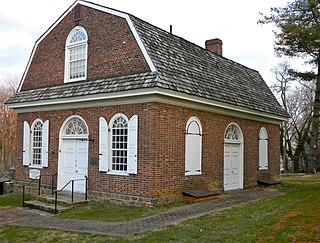
Old First Presbyterian Church of Wilmington is a historic Presbyterian church located on West Street on Brandywine Park Drive in Wilmington, New Castle County, Delaware.

Coffee Run Mission Site, also known as Coffee Run Church and St. Mary's Church, is a historic mission church site and national historic district located at Hockessin, New Castle County, Delaware. It encompasses two contributing buildings, both now demolished, and one contributing site. They were the Father Kenney House and stone barn with frame addition. The house was built in 1812, and was a two-story, three bay stone dwelling with a cross-gable roof. The Coffee Run cemetery is the burial ground of the first Catholic church in Delaware. It measures approximately 66 feet by 183 feet and includes over 50 carved headstones and 12 uncut stone markers. Located at the cemetery is a small cinder block building, which contains an altar, and stands at the site of the original log mission church built about 1790. It was the first Catholic church in Delaware out of which grew the present Roman Catholic Diocese of Wilmington. The house was demolished in March 2010 following an arson. The barn, also affected by arson, remained mostly intact but in a decaying condition. Trinity Community Church planned to restore it and incorporate it into a new church on the site, but discovered that the mortar was no longer sound. The barn was demolished in 2016 and the stone saved for reuse in the facade of the new church.

Starr House, also known as the Michael VanKirk House, is a historic home located at Wilmington, New Castle County, Delaware. It was built between 1801 and 1806, and is 2 1/2-story, brick dwelling with a gable roof. The house was restored in 1946 and considered the last example of colonial architecture in the city of Wilmington. Adjacent to the house is a mid-19th century frame summer kitchen, which contains a beehive oven, has been encased in brick.

New Castle Leather Raw Stock Warehouse, also known as the Kaumagraph Building, is a historic warehouse building located at Wilmington, New Castle County, Delaware. It was built in 1917, and is a three-story, rectangular steel, concrete, and brick building. The building measures 100 feet by 200 feet and features a projecting roof cornice, flat roof, and large window areas. It is characterized as a fireproof industrial building in the commercial style of the early 1900s. It was originally built as a warehouse to store goatskins for a Wilmington kid leather manufacturer and later housed the plant and offices of a specialty printing firm.
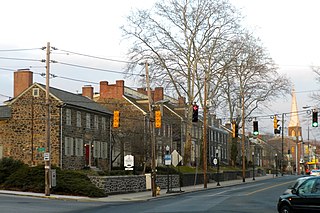
Brandywine Village Historic District is a national historic district located along Brandywine Creek at Wilmington, New Castle County, Delaware. It encompasses 12 contributing buildings, 7 contributing sites, and 2 contributing structures. Brandywine Village developed in the late-18th century as a group of flour mills, the homes of prosperous millers, mill workers, shop keepers and artisans. Located in the district are a set of mill owner built homes of granite. Notable buildings include the Gothic Revival style St. John's Episcopal Church (1857-1858) designed by noted Philadelphia architect John Notman, Brandywine Methodist Episcopal Church (1857), and Brandywine Academy (1798). In 1788, Brandywine Village was the site of the first mechanized mill designed by Oliver Evans.

Breck's Mill Area, also known as Breck's Mill Area-Henry Clay Village Historic District, is a national historic district located along Brandywine Creek at Wilmington, New Castle County, Delaware. It encompasses 56 contributing buildings, five contributing sites, and three contributing structures. The district encompasses The Mill, The Workers' houses, and The Mill Owner's Home.

Church Street Historic District is a national historic district located at Wilmington, New Castle County, Delaware. It encompasses 26 contributing buildings, 22 of which are single family fully attached rowhouse dwellings. They are primarily two-story, brick structures. It also includes a large Second Empire building which was originally a saloon and hotel, a bar and restaurant which also has Second Empire elements, and a smaller Queen Anne style store. The area developed between about 1880 and 1920 and many residents worked for the railroad.

Lower Market Street Historic District is a national historic district located at Wilmington, New Castle County, Delaware. It encompasses 132 contributing buildings the central business district of Wilmington. It includes attached commercial and commercial/residential structures dating from the mid-18th to the early-20th century. The buildings reflect a variety of popular architectural styles including Classical Revival, Greek Revival, Federal, and Art Deco. Notable buildings include the Farmers Bank (1912), Jake's Market, Wilmington and Brandywine Bank, Joshua Conner and Sons, J.T. Montgomery Jewelry Store, and Wilmington Publishing Company Building.

Rockford Park is a historic public park located in a residential area of Wilmington, New Castle County, Delaware. It is characterized by a large, grassy meadow which slopes gently upward to a large knoll overlooking the Brandywine River.
